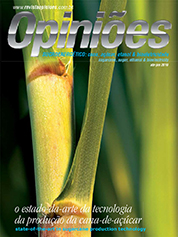Benjamin Raerup Knudsen
R&D Manager of Novozymes Latin America
Op-AA-24
The future of cellulosic ethanol is now
Maintain profitability using the renewable energy source sugarcane, based on the diversification of both end-products and production routes, will likely be the recipe for the Brazilian sugarcane industry to continue maintaining its world leadership in sugar and ethanol production. Cellulosic ethanol will be one of several routes that will secure boosting of the value-chain of existing and new mills, in parallel with present and new technologies for energy production from either combustion or methanification of cellulosic residuals.
Advances in improving the enzymatic solution have recently moved a step further towards commercially viable ethanol from cellulosic materials. Novozymes, in March 2010, launched a new cellulase complex, Cellic Ctec2®, which has helped bring the costs for cellulosic ethanol down to commercially relevant levels, especially in North America.
The cost reduction has been demonstrated in both lab and pilot scale by close collaboration with several strategic partners, including Centro de Tecnologia Canavieira of Brazil, on work with bagasse. The improvements made, compared to the most recent version of Cellic Ctec® are 1.5-2 times better in performance in similar enzyme loading for different feedstock.
For bagasse, the improvement observed was 1.6 times, significantly lowering the overall ethanol cost. More importantly, the advancements and the more robust enzyme solution gives more freedom to the tech-nology developers to increase total solid loading, not only lowering enzyme dosage to reduce the total en-zyme use cost, a tool for reducing capital cost intensity.
The significant cost share of enzymes in the total cost picture for cellulosic ethanol has long been considered the main barrier for reaching a viable cost, however with this latest advancement the enzyme cost share is now estimated to be below 30% of the total cost per liter of ethanol produced, considering C5 utilization. The main cost factor is now the capital cost investment, which shifts focus towards improving the energy integration and engineering costs for reaching a viable solution.
Novozymes has weighed the advantages and challenges of how to move forward with the development of cellulosic biofuel technology, and is setting the direction for process technology developed in our R&D labs. In absence of any commercially viable processes, Novozymes has developed a sophisticated model that allows us to see the tradeoffs through process alterations, a virtual bio-refinery.
By changing model pa-rameters, including enzyme dose, hydrolysis time, total solids level, and unit operation costs, we are able to accurately simulate different scenarios, including operational and capital costs – an essential tool when working with partners on process optimization. One example of gaining better insights and potentially better process design has been the development of the Fast Fermentation Concept (FFC) in North America, that simultaneously interacts in the fermentation of xylose and glucose without extending the overall process time.
By simulating process designs, such as simultaneous saccharification and fermentation (SSF) and separate hydrolysis and fermentation (SHF), the conclusions were promising. SSF is the industry standard for starch-based bioethanol, but shows suboptimal conditions for cellulosic feedstock. In contrast, SHF allows greater ethanol yields in a shorter time, since enzymes and yeast are able to operate under optimal conditions.
Novozymes has conducted sophisticated modeling to provide insight into the process of balancing these conditions with costs; FFC is the first concept to be developed using this insight, in which enzyme hydrolysis time is extended and fermentation time is compressed. This is a potential way to make SHF work and to share the cost forecast in cellulosic conversion processes.
Internal research and literature indicates that sugarcane bagasse and straw are somewhat more recalcitrant to enzymatic hydrolysis than compared, for example, with Corn Stover and Cobs, using similar pre-treatment technologies. Thus, bagasse is a “cheaper” feedstock readily available at the mill due to no additional transportation costs when compared to corn Stover in North America.
This is an obvious fact, but it is paramount to understand the implication on the overall process costs when setting process parameters and targets. Unquestionably, the industry faces challenges in moving towards commercialization of cellulosic biofuel – but exciting developments continue to move us closer to commercial viability.
One cornerstone for success and to harvest from prior experiences is to see the first demonstration plant online in Brazil. Other technology providers such as Inbicon in Denmark have already taken the step and are now gaining valuable insights from demo scale operation. The first enzyme solution for bringing cel-lulosic ethanol into the commercially relevant range is available. The leading Brazilian technology providers and innovators need - now - to step up to take advantage of the local presence and of industry insights to preserve domestic technology ownership.




